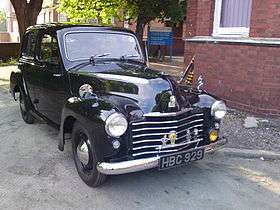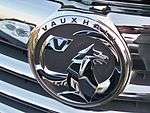Vauxhall Wyvern
| Vauxhall Wyvern | |
|---|---|
|
Vauxhall Wyvern Saloon (LIX) | |
| Overview | |
| Manufacturer | Vauxhall (General Motors) |
| Production | 1948–57 |
| Assembly |
Luton, United Kingdom Australia |
| Body and chassis | |
| Related |
Vauxhall Velox, Vauxhall Cresta |
| Chronology | |
| Predecessor | Vauxhall 12 |
| Successor | Vauxhall Victor |
The Vauxhall Wyvern is a medium-sized family car introduced by Vauxhall in 1948 as a successor to the Vauxhall 12. The name comes from the mythical beast the wyvern, and may be due to a misidentification of the heraldic griffin on the Vauxhall badge.
Wyvern LIX (1948–51)
| Vauxhall Wyvern LIX | |
|---|---|
 Vauxhall Wyvern LIX | |
| Overview | |
| Manufacturer | Vauxhall |
| Production |
1948–51 55,409 made[1] |
| Body and chassis | |
| Body style |
4-door saloon 2-door tourer (Australia) |
| Related | Vauxhall Velox |
| Powertrain | |
| Engine |
1442 cc Straight-4 35 bhp (26 kW) |
| Dimensions | |
| Wheelbase | 97.75 in (2,483 mm)[2] |
| Length | 164.5 in (4,178 mm) [2] |
| Width | 62 in (1,575 mm)[2] |
| Height | 65 in (1,700 mm) [2] |
| Chronology | |
| Predecessor | Vauxhall 12 |
The L series Vauxhall Wyvern along with the Velox were Vauxhall's first post-war new models; incorporating American influence, it started production in September 1948 and finished in July 1951. Many of these went for export to help the British economy. The Wyvern was fitted with a 1442 cc four-cylinder engine with 35 bhp with a top speed of 62 mph. The optional extras available were a radio/heater/foglight. These vehicles are forgotten classics with very few surviving.
Wyvern EIX (1951–57)
| Vauxhall Wyvern EIX | |
|---|---|
|
Vauxhall Wyvern EIX (1952) | |
| Overview | |
| Manufacturer | Vauxhall |
| Production |
1951-57 110,588 produced [3] |
| Body and chassis | |
| Body style |
4-door saloon 2-door convertible (Australia) 2-door coupe utility (Australia) |
| Related | Vauxhall Velox, Vauxhall Cresta |
| Powertrain | |
| Engine |
1442 cc Straight-4 35 bhp (26 kW) (1951–52) 1508 cc Straight-4 45 bhp (34 kW) (1952 - 1957) |
| Dimensions | |
| Wheelbase | 103 in (2,616 mm)[4] |
| Length |
172.5 in (4,382 mm) (1951 - 1952)[4] 170.75 in (4,337 mm) (1952 - 1957) |
| Width |
67 in (1,702 mm) (1951 - 1952)[4] 66.5 in (1,689 mm) (1952 - 1957) |
| Height | 63 in (1,600 mm) [4] |
In August 1951 a completely new Wyvern was launched, featuring a modern Ponton, three-box shape in a monocoque body. In spite of the abandonment of the old RAC horsepower tax system which favoured long stroke engines, the old long stroke four cylinder 35 bhp (26 kW) engine from the L-series was retained and permitted a claimed top speed above 62 mph (100 km/h) despite the car's increased size. As before, a more powerful Vauxhall Velox was available with the new body.
5313 were made.[3]
After only six months production of the rebodied Wyvern the car received, in April 1952, Vauxhall's new short stroke 1508 cc four-cylinder engine. Along with its six -cylinder Velox version, the new engine had a bore of 79.3mm and a stroke of 76.2mm, identical measurements (and therefore capacity) as the rival Ford Consul/Zephyr engines introduced two years previously. With a power output of 45 bhp at 4,000rpm, maximum speed rose to 72 mph (116 km/h). More performance was available from the six-cylinder Vauxhall Velox and (from 1954) Cresta versions.
The EIX series Wyvern received a new bonnet and grille in 1955, a wrap-round rear window in 1956 and another new grille in 1957.[5]
The Wyvern sold well on the UK market until Vauxhall abandoned the six seater four cylinder market and replaced it with the smaller but more radically styled Vauxhall Victor F-Series in 1957.
A car with the 45 bhp (34 kW) engine tested by the British magazine The Motor in 1952 had a top speed of 71.6 mph (115.2 km/h) and could accelerate from 0–60 mph (97 km/h) in 37.2 seconds. A fuel consumption of 30.4 miles per imperial gallon (9.3 L/100 km; 25.3 mpg-US) was recorded. The test car cost £771 including taxes.[4]
105,275 were made.[3]
.jpg)
Australian production
General Motors-Holden's produced a Vauxhall Wyvern model in Australia from 1938 to 1957.
H Series
GMH introduced a locally built Vauxhall Wyvern model to the Australian market in 1938, ten years prior to the use of the Wyvern name in England.[6] Based on the British Vauxhall H Series, it was produced in Sedan, Roadster, Tourer and "Caleche" body styles, the latter being a two-door roadster with a folding windscreen.[6] The Wyvern had a 94-inch wheelbase and used a 10 hp engine. Production ceased in 1941 but was resumed in 1946, using pre-war tooling.[7]
L Series
.jpg)
The L Series Wyvern was produced from 1948 to 1951. It was offered with an Australian developed Sedan body, an Australian "Caleche" Tourer body or with the English Sedan body. The Australian Sedan differed from its English counterpart in having a more rounded boot and an additional side window behind the rear doors.[8]
E Series
.jpg)
The E Series Wyvern was produced from 1952 to 1957.[9] In addition to building a 4-door sedan, GMH developed a 2-door convertible and a Coupe Utility.[10] The convertible was initially marketed as the Caleche and later as the Vagabond.[11] 1954 was the last year for the Coupe Utility,[10] and the Vagabond was not included in the facelifted E Series range released in April 1955.[12]
References
Citations
- ↑ Sedgwick & Gillies 1993.
- 1 2 3 4 "The Vauxhall Wyvern". The Motor. 4 October 1950.
- 1 2 3 Sedgwick & Gillies 1993, p. 212.
- 1 2 3 4 5 "The Vauxhall Wyvern (short stroke)". The Motor. 10 September 1952.
- ↑ Sedgwick & Gillies 1986, p. 212.
- 1 2 Darwin 2002, p. 130.
- ↑ Darwin 1983, p. 79.
- ↑ Darwin 2002, p. 133.
- ↑ Darwin 2002, pp. 134–136.
- 1 2 Darwin 2002, p. 134.
- ↑ VAUXHALL VELOX and WYVERN - 1952 SEDAN and VAGABOND BROCHURE, www.ebay.com As archived at www.webcitation.org on 10 September 2014
- ↑ Darwin 2002, p. 135.
Bibliography
- Darwin, Norm (1983). The History of Holden in Australia since 1917. E.L. Ford Publications. ISBN 978-0-9592287-0-0.
- Darwin, Norm (2002). 100 Years of GM in Australia.
- Sedgwick, Michael; Gillies, Mark (1986). A–Z of Cars 1945–1970. Osprey. ISBN 978-0-600-33391-3.
- Sedgwick, Michael; Gillies, Mark (1993). Pressnell, Jon, ed. A–Z of Cars 1945–1970. Bay View Books. ISBN 978-1-870979-39-9.
Further reading
- Culshaw, David; Horrobin, Peter (1997). The Complete Catalogue of British Cars 1895–1975. Veloce Publishing. ISBN 978-1-874105-93-0.
External links
- Vauxhall Wyvern 1937, www.vauxhall.org.au
- Images of Vauxhall L Series tourer, E Series Utility and E Series Vagabond Convertible at www.kpl.com.au
